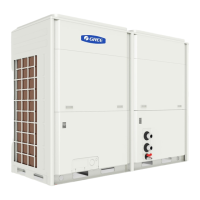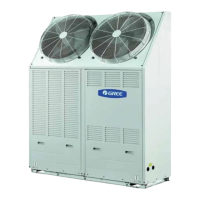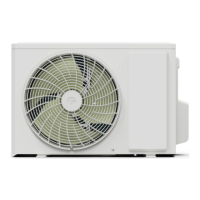100
Test Operation, Troubleshooting and Maintenance
(2) Recharge refrigerant
Low-pressure gauge
High-pressure gauge
Manifold gauge
Hose
Hose
Refrigerant tank
Charging process
Excessive or deficient refrigerant may cause abnormal operation, malfunction or damage to a
compressor, so charge volume must comply with the requirements on the unit nameplate which have been
decided in strict tests; The gure may serve as a reference; a charge process is as follows (one system
as an example):
Step 1: Place a refrigerant container on an electronic scale and connect the container and the pressure
gauges by a exible tube.
Step 2: Remove gases inside the exible tube—half turning the shut-off valve of the container, loosen
the joint device between the exible tube and pressure gauge; tighten the joint device when a sound is
sent out for 5s.
Step 3: Power up and down the electronic scale to enable it to reset.
Step 4: Ensure that the flexible tube has been evacuated and the scale reset, turn on all valves
connecting refrigerant containers and the unit; charge refrigerant required by the nameplate to prevent
oil dilution caused by excessive charging, and inhibit a capacity decline of the unit induced by insufcient
charging; when the unit is running, make sure it is gaseous refrigerant (as possible as it can be) from a
refrigerant container (that cannot be turned upside down) that is injected into refrigerant nozzles on intake
lines; when the unit powered down, be sure to charge refrigerant via the refrigerant nozzle at the high-
pressure side (if there is no nozzle at the high-pressure side, low-pressure side is an alternative.) in case
of liquid slug.
4.5.2 Air removal
When there is air trapped in the system, expel them before charging refrigerant. The whole system
must be vacuumed in accordance with the steps stated below.
(1) Connect pipes for vacuuming at both the low and high pressure sides.
(2) Start the vacuum pump for vacuuming.
(3) When it reaches the targeted vacuum degree, charge refrigerant into the system. See the
nameplate for type and charging mount of refrigerant. Do charging from the low pressure side. A
manifold gauge should be connected to both the low and high pressure sides.
(4) Refrigerant charging would be affected by environment temperature. If refrigerant is undercharged,
start the water pump to circulate chilled water and meanwhile start the unit for refrigerant adding. In
this case, vapor refrigerant should be charged.

